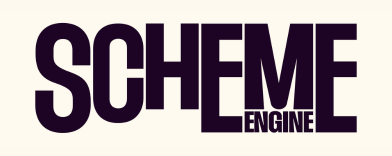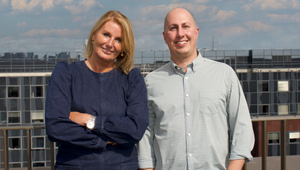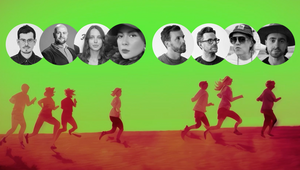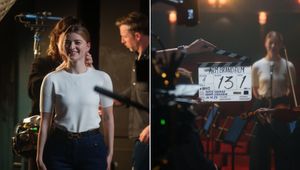
The Neuro-Mixology Experiment for Tanqueray No. TEN That Turned Dreams Into Cocktails

When a mixologist asks you what sort of cocktail you like, do you really – in your heart of hearts – know the answer? Tanqueray No. TEN’s ‘Cocktail of Dreams’ campaign is trying to get to the truth of the matter, exploring subconscious flavour preferences by harnessing EEG technology.
In the experiment dreamed up by VML UK and realised via MyndPlay’s tech, a curated group of creative ‘Dreamers’ were exposed to scents and sounds in both awake and relaxed states, revealing unexpected tastes via Diageo’s FlavorPrint analysis. Three bartenders then translated these unique brainwave-driven profiles into bespoke cocktails, blending artistry and science.
Debuting at events like Milan Design Week and Cannes Lions, the campaign invites consumers to discover dream-inspired recipes online before sampling them. By turning dreams into drinkable experiences, it challenges convention, personalises tastings and elevates Tanqueray No. TEN’s narrative of craftsmanship and innovation.
LBB’s Alex Reeves caught up with executive creative director at VML UK, Marco Bezerra, to hear how the team got to the idea, and how they managed to make their dream into a reality.
LBB> How did this concept start out for VML?
Marco> It all began with a simple question: how does the subconscious shape our flavour preferences? We wanted to uncover whether the tastes people dream about could reveal hidden cravings. Early on, we discovered that – even within the innovative world of gin – most drinkers tend to stick to familiar flavour profiles rather than push creative boundaries.
We then dived into Tanqueray No. TEN’s heritage of ingredient-led craftsmanship. The brand team challenged us to develop a truly luxurious platform that elevated their story. That spark led us to the idea of translating dreams into bespoke cocktails – though at first we had no roadmap for how to make it happen. Only after exploring EEG technology and bringing together neuroscientists, mixologists and other specialists did the concept begin to take shape.
LBB> How did the notion of luxury evolve into translating dreams into cocktails?
Marco> Luxury is ultimately defined by craftsmanship. From the very beginning, we knew our concept had to showcase extraordinary levels of artistry to reinforce that Tanqueray No. TEN is no ordinary gin – while still feeling entirely exclusive. At first, we even debated keeping the recipes secret at special events, before deciding they should be shared more widely.
Our key challenge then became: how do we guide people into their subconscious to uncover flavour preferences they aren’t aware of when they’re awake? We explored hypnosis and various immersive ideas, but in the world of spirits those methods quickly proved impractical. That’s when we turned to EEG technology. It provided a scientific, data-driven way to measure how different scents and sounds resonated with the brain, revealing genuine, unfiltered responses.
In many ways, it was like the classic bartender’s question – “What do you like?” – but instead of answering consciously, our participants replied in a dream state. We had no idea whether their subconscious tastes would align with their waking choices; frankly, we were secretly hoping for a dramatic difference. The mixologists felt that same excitement (and a fair amount of nerves), crafting initial recipes the night before, only to revisit and refine them the next morning based on the brainwave insights. It turned into one of the most exhilarating experiments I’ve ever worked on.
LBB> The idea is really conceptual, which is kind of the fun of it. How did you make sure that it was actually fairly tangible? You’re taking these abstract concepts and trying to find something concrete to tie them to. What were the key points there?
Marco> The key was assembling the right experts. From the outset, our main challenge was figuring out how to operationalise the experiment, so we partnered with leading universities and tapped into Diageo’s in-house flavour-profiling algorithms to understand how they group and organise taste data. EEG is typically used only in wakeful states, so we brought on board neuroscientists curious to test its reliability during relaxation and light sleep – our findings even attracted broader scientific interest.
We also enlisted a relaxation specialist to guide participants into a calm, dream-like state. As it happened, our ‘Dreamers’ were fatigued enough to drift off easily, which allowed us to capture authentic brainwave responses to different scents and sounds. By combining these disciplines, we turned a conceptual idea into a fully tangible, data-driven cocktail experiment.
LBB> How did you actually run the process and what happened?
Marco> We kicked things off by recording each Dreamer’s flavour responses while they were fully awake, exposing them to a curated selection of scents and sounds and capturing their EEG data. Next, we guided them into a relaxed, near-sleep state and repeated the exercise to reveal their subconscious preferences.
For example, Sam – a chef by trade – consciously gravitated towards garlic and other savoury notes, yet in his dream-state readings he showed an unexpected liking for fruity and liquorice flavours. When he took that first sip, he had been bracing for garlic but instead got liquorice, watermelon with Tanqueray No. TEN and all sorts of other flavours.
Meanwhile, when Thai De Melo tasted her bespoke creation, she became visibly emotional. Certain flavour combinations unlocked childhood memories she hadn’t revisited in years. Seeing those genuine, unguarded reactions live brought a powerful sense of reality to our experiment – and reminded us how science and craft together can create truly unforgettable moments.
LBB> How did the experiment evolve from there?
Marco> Then our curiosity just exploded: “What’s really going on in these flavours? I need to taste what’s inside this person’s mind!” That spark has driven the project forward. We’ve already taken it to Soho House, and we’re gearing up for Cannes, giving guests the chance to sample the dream-crafted cocktails, explore the concept and see exactly how our data translated into each unique flavour profile.
Some people worry it might feel intangible or like pseudo-science, but we’ve put it through its paces. Of course there’s still a layer of interpretation and pure creativity – after all, we don’t yet have a robot that can flawlessly design and mix cocktails for us. But that’s part of the magic. We simply asked: what’s hiding in your subconscious, and how can we turn that into a tailored taste experience?
LBB> It’s a really interesting provocation for neurologists, technologists – and advertising creatives as well. This is new for everyone involved!
Marco> It was wild from the very start. Bringing neurologists, psychologists, creatives and clients together created a constant buzz of curiosity and excitement. Scientists leaned in to study the EEG readings, while creatives and clients paused mid-shoot to taste the cocktails. Working across so many disciplines was intense, but we kept the energy positive throughout the year-long journey.
We honestly had no idea what to expect – how to guide people into that dream-like state, what data we’d capture, or whether their subconscious tastes would simply echo their waking preferences. There was a real risk someone might despise their drink, or that the data would reveal nothing new, which would have killed the whole concept. The nerves were through the roof, but that uncertainty made every moment thrilling.
In the end, a project like this only happens because of the client’s boldness. We creatives throw out ideas, but it’s the brand that signs the cheque, faces the KPIs and chases the ROI. They deserve all the credit – and any awards – because backing an untested concept with real investment is far braver than dreaming it up.
LBB> What does ROI look like on something as kind of conceptual as this?
Marco> We started by defining clear metrics: PR reach, social engagement figures and, crucially, live brand-experience data at our events. The goal is to create genuine curiosity – at every exclusive activation, guests leave with a story and a tangible way to connect with Tanqueray: a cocktail that lets them ‘drink’ someone else’s subconscious. That buzz, both online and offline, is something we can track and analyse.
We’ve already proven the concept in three markets, and it’s entirely scalable. Any region can adopt the experiment – simply pick a local influencer and we’ll replicate the process, generating fresh data and engagement each time.
Looking ahead, the real value lies in unlocking creativity in people who wouldn’t normally experiment with flavour. As we grow older, most of us fall into a comfort zone of familiar tastes. For a gin brand to expand its audience, we must challenge that predictability, inviting drinkers to stretch their palates – and in doing so, build a broader base of passionate fans.















